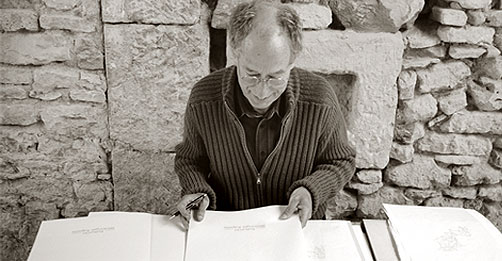5
spring – ver
Pèlerinage - pilgrimage with the eyes
Miniatures by Till Neu

The space should not be disturbed, that is, not cut, installed or furnished. Preserve the emptiness. Do not over-form the character of the Gothic architecture. Do not hang the walls with niches and open walls. No grand gestures that touch the rhythm of the stones, niches, pillars and services. Miniatures!

The remnant of a medieval sacred building, the Wintringer Chapel, is my workplace for some time. How beautiful: an empty space, rich in history. No liturgies, no equipment, no altar. The sandstones of the masonry visible, the windows and doors transparent. How were the walls once painted? Sculptures on the west portal, perhaps? Expulsion from paradise? Apocalypse?
The "chapel" today: a precious, empty vessel. The history of salvation is no longer preached. With a new openness, the building awakens sensations for its history. It evokes images that connect with hopes and fears of our present. A place of melancholy and inspiration. There I carry my miniatures, so large that our eyes can wander along them, so small that the stone formats of the walls correspond with them.

My pictures tell of an imaginary pilgrimage across time. Probably the Wintringer Chapel was located on a St. James pilgrimage route that led from Speyer to Metz and at the end to Santiago da Compostela. Everyone was allowed to go on pilgrimage: believers and non-believers, poor and rich, women, men, children. At that time, the pilgrimage was also seen as a parable for our journey through life. We encounter good, evil, love, violence, peace and disaster, death. Perhaps some ghosts and fleeting spirits, near us or far away.
On twelve sections of the wall are placed all around 32 miniatures for that pèlerinage with the eyes. Images of medieval art and signs of our time can speak to us simultaneously. Emptiness of space and intimate proximity to the images belong together ...
My works will correspond with the stone formats and the wall surface rhythm. Ten sections with three niches I count all around, except the west wall. The visitor could "read" or "pilgrimage" on the wall reading. It is my chance: to work freely and considerately in relation to the place. I will decorate the "chapel"...

Exhibition opening, Prof. Dr. Andreas Eichhorn, "Flute", Syrinx, Claude Debussy "Danse de la Chèvre", Arthur Honegger


A limited edition print "The Dream of Pilgrimage" has been published to accompany the exhibition and is being sold as a building block to benefit the Wintringer Chapel. Price: 50, - €. Edition: 70 copies. Format: 16 x 16 cm. Signed and numbered on copperplate Hahnemühle, 300 gsm. Approx. 30 x 42 cm. Printed with the kind support of the printing workshop of the HBK Saar.
The Wintringer Chapel is called "cultural site"
It is neither a sacred space for practicing Christians nor a \u201new gallery in the countryside\u201c. It stands in the midst of a diverse, ecologically oriented agriculture that cooperates with Lebenshilfe Obere Saar e.V. for people with disabilities. In this respect, the "Chapel" is spatially embedded in real life, but exquisitely "njoyable" in other ways.
It is an empty space
While outside economic and ecological exchange between people, animals and plants is organized and production is carried out, this life continues between the walls of the "chapel". Thus it becomes possible that in principle and in the individual case, a talent of homo sapiens, surprisingly pronounced for some in the evolution, can live itself out here: To think about existence and finiteness, to question and comment on life's events.
The place of performance of that life transformed into image, word, sound or movement and the place of the accompanying discourses, that is the cultural site. There, too, the questions of life and survival are "worked on." The Christian message of salvation is only fragmentary - almost no longer legible, but the fine architectural structure of the section symbolizes a believed conviction. With its immediate charisma, the beautiful "chapel" can attract visitors even in the 21st century.
Source and refuge
In the last four years, however, it has been visited by so many people (and has won friends) primarily because the Saarbrücken City Association, together with the Regional Development Office, has realized an exemplary concept. In retrospect, it sounds so simple what twelve times succeeded quite differently: the cultural site Wintringer Chapel was an inspiring source and refuge for performances of contemporary culture. The medieval building was awakened with the "spirit leaping over the wall". Strangers and close visitors raved about the small place with which the region's inhabitants are so deeply connected.
Variety of ideas and the "changing sensualities" of the four times four seasons anno 2004-2007 have brought culture lovers, tourists, hikers and passers-by to the cultural site Wintringer Chapel.
A spark of hope in the midst of an overly economically determined life.
Till Neu, May 2005
